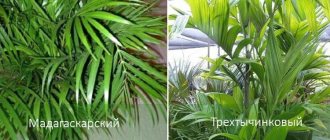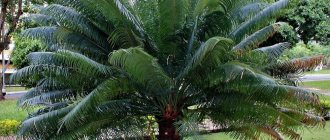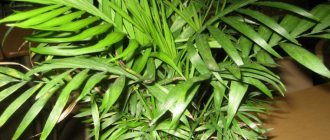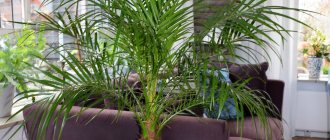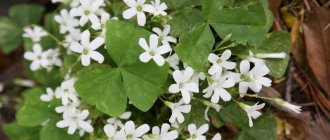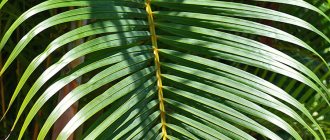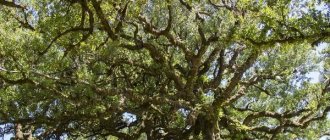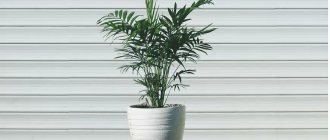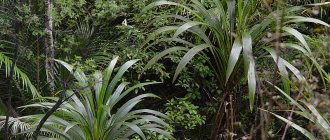Botanical description
Chrysalidocarpus is considered a member of the Palm family, a subfamily of Arecaceae, which has 20 species. The multi-stemmed palm came to us from Madagascar and the Comoros Islands. Locals call the plant the butterfly palm because of the unusual appearance of the leaves, reminiscent of a feathery fan.
In nature, the evergreen plant reaches a height of 7 to 15 meters. In Russia, in protected areas under the roof - from 2 to 5 meters.
Dangerous! The seeds in the fruits are toxic and, if ingested, destroy the mucous membrane.
The palm tree has an amazing feature: it is capable of extracting moisture not only from the soil, but also from the air , but in a dry room it is capable of releasing moisture. One species is cultivated at home - yellowish chrysalidocarpus. Under favorable conditions it grows up to 1.5 -2.0 meters in height. Over the course of a year it adds only 30 cm, but grows in width due to the formation of side shoots.
The originality of the palm lies in the absence of a pronounced trunk. Several herbaceous shoots, similar to reed stems, grow from the ground at the same time.
It blooms under natural conditions in May-June, after which yellow fruits with a hint of gold are formed from self-pollinating buds. It begins to bear fruit 2-3 years after planting.
Relatives of the single-stemmed Chrysalidocarpus are known.
Benefits and uses of chrysalidocarpus
According to signs, chrysolidocarpus imparts positive energy and relieves negative emotions. Purifies the air from harmful substances: benzene, formaldehyde; increases air humidity, enriches with ozone and oxygen.
Despite the poisonous nature of the plant, it is used as an anthelmintic for diarrhea. In the Philippines, palm is grown to make chewing gum.
Chrysalidocarpus is a palm tree of the Arecaceae family, widespread in indoor culture. The genus got its name due to the yellowish color of the fruits. Translated from ancient Greek chryseus means golden and karpos means fruit. The homeland of chrysalidocarpus is the territory of the Comoros Islands and Madagascar. Sometimes palms of this group are called by the outdated name areca. The genus includes about 20 species. The local name for this plant is butterfly palm. Only one species is grown in the rooms - Chrysalidocarpus yellowish (C. lutescens).
Chrysalidocarpus belongs to the so-called reed palms, which do not have a central trunk - they grow as a bush consisting of many leaves. Its leaves are up to 90 cm long, graceful, pinnate; their yellowish petioles resemble reed stems. Thanks to its finely dissected leaves and numerous stems, chrysalidocarpus produces a lush crown that can decorate any interior.
The optimal temperature is 20–22 °C (should not fall below 15 °C). In partial shade the plant feels quite comfortable. Regular watering: the soil should be constantly moderately moist. In summer, when it is especially hot, it is advisable to leave water in the pan. The leaves must be sprayed with warm, soft water. Please note that palm trees usually react negatively to transplants, so do not do them unless necessary. Recommended soil mixture: turf, leaf soil, humus, peat and river sand (2:2:4:1:2). Chrysalidocarpus is fed from March to September once every 2–3 weeks with complex fertilizers.
Propagated by seeds (rarely) and division of rhizomes in spring.
Chrysalidocarpus increases air humidity, enriches the air with ozone and oxygen. Capable of imparting energy. Even one plant can create the feeling of a real thicket in your home. Removes harmful chemicals from the air. It is believed that the energy of chrysalidocarpus, like most palm trees, is dual: it gives positive energy and takes away negative energy.
Chrysalidocarpus is an exotic palm-shaped plant that can become a real decoration for your home.
Caring for it is quite simple and does not take a lot of time and effort.
The palm tree will fit perfectly into your home environment and decorate the interior.
What is the difference between Chrysalidocarpus and Hamedorea?
Palm trees are mainly distinguished by their appearance. Chrysalidocarpus grows in two forms - as a bush and a single-stemmed palm. The smooth stems are covered with fluff and there is swelling in the places where the rings are located. Lateral shoots may arise from the shoots, forming a group. The ends of the leaf blades are pinnate, dissected at the ends. The color of the leaves is bright green interspersed with small black dots.
Hamedorea has a much larger number of leaf lobes, which droop downward at the ends. The leaf blades are darker and more saturated in color than those of chrysalidocarpus.
The main difference is noticeable during flowering. Hamedorea inflorescences have the appearance of a loose panicle, while areca has yellow inflorescences that are more dense with a frequent arrangement of flowers. The height of Hamedorea is limited to one meter, Chrysalidocarpus - twice as high.
Answers on questions
Question No. 1. When purchasing chrysolidocarpus, its petioles were covered with a scaly shell. Over time, it disappeared, revealing small black dots. Is this a manifestation of some kind of disease or pest infestation?
Small black markings on the base of the stem are a biological feature of Chrysolidocarpus yellowish. Moreover, this trait manifests itself with age. In young plants, the base of the stems is covered with a dark brown sheath. When it disappears, black dots appear on the petioles. Due to inexperience, they are mistaken for symptoms of damage by ticks, scale insects and other parasites. To make sure that it is not an attached pest, just pry the growth with your fingernail.
Question No. 2. How to properly prune chrysolidocarpus?
All indoor palm trees have a common biological feature. Over time, the lower leaf plates dry out and die. But under no circumstances should you trim leaves that have changed color to yellow or brown, but still have a green part. Withering leaves provide an additional source of nutrients for the plant. The more actively you remove “half-living” foliage, the faster the process of dying off of fresh young leaves will go. Only completely dead, broken, infected leaves, as well as those bent below the horizontal, are trimmed. When pruning, you need to be extremely careful so as not to accidentally damage the palm trunk. It is unacceptable to pick leaves with your hands; they should be trimmed with a sharp, sterile instrument.
Yellowish
Chrysalidocarpus yellowish is most often grown as a houseplant in a pot and grows in bush form. Synonym for the generic character dipsis. This species is threatened with extinction in nature, therefore, in the Red List of Endangered Plants, the variety is assigned NT status due to the reduction in the number of the crop.
The plant has special care requirements. Prefers to grow in slightly acidic soil with a pH of 0.0-6.0, does not like moisture retention when watering, but develops well with regular spraying.
You can see what the Chrysalidocarpus Yellowish variety looks like in the photo below:
Chrysalidocarpus Yellowish
Chrysalidocarpus
Chrysalidocarpus (Chrysalidocarpus) is an ornamental palm tree, very popular among gardeners due to the exotic beauty of its leaves and low maintenance requirements. This is a tropical heliophyte, that is, a light-loving plant, native to the Comoros Islands and Madagascar. The name translates as "golden fruit", in Greek "chryseus" and "karpos". Belongs to the palm family and type genus Arecaceae.
Chrysalidocarpus in nature has about 20 species; only one of them is cultivated for indoor cultivation - Chrysalidocarpus yellowish. Areca palms are both single-stemmed and multi-stemmed bushy plants with straight, non-branching, smooth shoots, growing more than 10 m in height. It has carved pinnate leaves, long and wide, in pairs, 40-60 pieces per stem. Numerous stems of chrysalidocarpus form a lush crown, the beauty of which will add charm to any interior.
Madagascar
The peculiarity of the Chrysalidocarpus Madagascar palm tree is the presence of a strong, smooth trunk on which rings with a diameter of 20-25 cm are visible. Cirrus leaves with a characteristic smooth surface usually grow in bunches. The length of the leaf blade is slightly less than half a meter and usually its size is 40-45 cm, which cannot be said about the width, which is small - 1.5-2 cm.
The photo below shows Chrysalidocarpus Madagascar:
Chrysalidocarpus Madagascar
Popular types
There are 8 species of plants classified in the genus Chrysalidocarpus. The two most popular types of chrysalidocarpus that can be found in stores are:
- Chrysalidocarpus yellowish (Ch. lutescens Wendl). Synonym: Diptis yellowish. There is a name Chrysalidocarpus lutescens. From one base grows 2-5 yellowish trunks strewn with small black dots. Leaf petiole up to 60 cm, yellow, grooved.
- Madagascar (Ch. madagascariensis). Synonym – Diptis Madagascar. Smooth, slightly widened below trunk, with pronounced rings. The leaves are pinnate, with a glossy surface, the leaves are arranged in a bunch.
You can learn more about the most common types of palm trees, as well as see photos of the plant here.
This video talks about the Chrysalidocarpus yellowish palm tree.
Lutescens
The Lutescens palm lacks a central trunk. The stems of the plant develop powerfully and grow closely adjacent to the trunk. The gracefully curved leaves have a feathery shape with a characteristic yellowish tint. It blooms in late spring - early summer with yellow flowers united in dense branched inflorescences. The fruits formed after flowering have the same yellow color.
In the photo below is the variety Chrysalidocarpus Lutescens:
Chrysalidocarpus Lutescens
Diseases and pests
Chrysalidocarpus, like many plants, is susceptible to fungal diseases. If damage occurs, brown spots with a red tint appear on the leaves of the palm tree.
Their configuration can be oval or round. Without adequate disease control, the lesion grows over the entire leaf. Therefore, if the grower notices the presence of a fungal infection, then the chrysalidocarpus must be treated with fungicides.
Keep in mind: with high air humidity there is a risk of fungus developing on the plant.
Pests living on palm trees include scale insects. It provokes yellowing of leaves and also damages them. You need to fight it with cotton wool soaked in alcohol.
In addition, the plant is vulnerable to mites - they cause the formation of yellow specks and then cause the leaf to dry out. In case of infection, it is necessary to treat the palm tree with Acaricide.
Care
Since the palm tree is considered a tropical plant, the scorching sun is not harmful to it. But young plants at high temperatures may suffer from excess sunlight.
Lighting
The plant is tolerant of partial shade and bright indirect sunlight, but excessive shading should be avoided. Direct sunlight can damage young chrysalidocarpus seedlings, causing the leaves to begin to turn yellow and curl. Without protection, the palm tree sheds its leaves and dies when it is exposed to the sun at its hottest from 11:00 to 16:00. At this time, it is better to shade the palm tree if it is not possible to move it to another place.
After chrysalidocarpus reaches the age of 6 years, there is no need to be afraid of the sun. The plant will be well lit when placed on south and southeast windows. From July to August, shading windows with tulle or paper saves you from the midday heat.
Expert opinion
Victoria Goncharova
Specialized education: landscape designer, agronomist, gardener. Experience in caring for potted fresh flowers/plants at a professional level!
Do not forget! To prevent it from being dense on one side and empty on the other, rotate the chrysalidocarpus 2 times a month around its axis by 180 degrees.
Temperature
Choosing a location and lighting level
An open place for the palm tree is chosen, given that the leaf plates reach a length of more than two meters, annually adding 15-20 cm in height. In cramped conditions, the plant will feel uncomfortable, which will negatively affect its appearance . It is unacceptable to place chrysolidocarpus near operating heating devices, in a draft or in the area of operation of an air conditioner.
Chrysalidocarpus prefers bright light, but does not tolerate direct exposure to sunlight on the foliage. This is especially true for young (up to 5 years old) plants. Even short-term insolation at this age causes yellowing of leaf blades followed by death. Adult chrysolidocarpus tolerates exposure to ultraviolet radiation more easily. Under the scorching rays of the sun, the leaves do not die, but they noticeably lighten and lose their attractiveness. The best location is a room with windows facing southeast. On a summer afternoon, shading with a light curtain is recommended.
Important! In order for a young chrysolidocarpus that is gaining vegetative mass to develop a symmetrical crown, it should be rotated regularly, at least once a week, around its axis. This way the leaves will not be pulled to one side.
Recommended by topic
Basella Hamedorea Crocuses Temperature changes are not a problem for palm trees after 10 years of life.
They can withstand short-term temperature drops to +13°C-16°C; the palm tree cannot tolerate temperatures below 14°C. For young chrysalidocarpus in the summer season, the favorable temperature is 22°C-25°C. In winter – within the range from 18°C to 23°C, but not less than 16°C. Ventilation of the room where the palm tree grows becomes a prerequisite in the summer. It is necessary to avoid drafts, since cold air harms the leaves, which begin to wither due to the disappearance of the protective layer from the leaves and loss of moisture, and may fall off. Free air circulation must also be ensured in winter. If the palm tree is small in size, you can take it out of the room while airing. It is important to protect chrysalidocarpus during transportation from the store by creating a draft barrier with packaging material.
Humidity and watering
Moist air is vital for palm trees. It is ideal for the plant when there is a humidifier in the room, especially when the heating system is turned on in winter. You can get out of this situation on a budget by placing the chrysalidocarpus on a tray with damp gravel or placing a container of water nearby.
You can practice regularly wiping palm leaves with a wet sponge dipped in settled water at room temperature. Removing dust allows the plant to breathe better and absorb more oxygen from the air.
In winter it sprays the palm tree once a week, in the summer season - 2-3 times. The plant gratefully responds by growing green mass to bathing in the shower. First you need to cover the soil in the pot with plastic wrap. This procedure is carried out once every 2 weeks.
Chrysalidocarpus is most thirsty in the summer, especially if the sun shines on the plant. Water the palm tree as the top layer of soil dries to a depth of 2-3 cm. It is important to prevent the root system from drying out. The water must be settled. Soften the water with several crystals of citric acid.
Palm trees develop well when watered:
Thaloy
Rain
The plant should not be allowed to overwater, as this stops the development of the root system, it begins to suffocate and rot. The regularity of watering in summer is 2-3 times a week; in winter, watering is reduced to once a week. In winter you need to focus on the condition of the palm tree; here it is better to act according to the principle - it is better to under-water than over-water.
Top dressing
Palm trees are fertilized from April to August. This is the key to success in growing a beautiful plant. In spring and summer, the frequency of fertilizing is 2 times a month. For feeding, it is better to use a complex fertilizer for decorative deciduous plants or a special fertilizer for palm trees.
During the growing season, foliar feeding is practiced by spraying the leaves with a weak solution of fertilizers.
Nutrient deficiency is determined by the appearance of chrysalidocarpus:
The light green color of the leaves indicates a lack of nitrogen and stunted growth.
Magnesium - the appearance of a light yellow stripe along the edge of the leaf
Potassium - in orange islands on the leaves
Zinc – along small necrotic brown spots
Unexpressed chlorosis manifests itself from a lack of magnesium. These points must be taken into account when selecting fertilizers, and focus on complex species that contain all the microelements necessary for the successful development of the plant.
Transfer
Chrysalidocarpus has an extremely negative attitude towards transplantation. Transshipment with subsequent filling of soil is used. The palm tree is replanted only when there is a possibility that the pot will rupture due to roots coming out. Young palm trees need to be replanted every year, adult plants - once every 3 years.
It is optimal to transplant in April with the obligatory preservation of the earthen coma.
Some of the roots that have become tangled and turned into a felt layer are cut off. Transfer the palm tree to a new pot in such a way as not to deepen the palm tree trunk. It should coincide with the ground level before replanting. When chrysalidocarpus is grown in a tub and the palm tree has reached an impressive size, the top part of the soil is removed and replaced with new one. It is unacceptable to transplant a small chrysalidocarpus into a large pot, since the plant is not able to absorb all the water when watering and will die due to rotting of the roots.
Priming
Signs of good soil for chrysalidocarpus lie in the ability not to retain water when watering. When water is retained through the drainage hole for more than a minute, this indicates that the soil is heavy and needs to be drained.
For drainage use:
Pebbles
Large perlite
Peat
Coarse sand or 2 cm pieces of wood chips
If the substrate contains clay soil or fine sand, these elements reduce soil drainage.
You can buy ready-made soil specifically for growing palm trees in a store or prepare it yourself:
2 parts leaf humus
2 parts perlite
1 part turf land
You can use a different composition - take in equal parts:
Pumice
pine bark
Charcoal or perlite
Dolomite crushed stone or pebbles
Then add to this composition:
Two parts of peat
1/10 part bone meal
The ideal soil for palm trees is acidic or neutral acidic, with a pH value of 6-7.5.
Transfer
Chrysolidocarpus under the age of 10 years is recommended to be replanted annually in slightly larger containers. Adult specimens are replanted less frequently - every 3-4 years, as needed. Chrysolidocarpus has difficulty recovering from any damage to the root system, so they do not practice radical replanting, but transshipment - removing the rhizome along with the entire earthen lump, replacing the drainage and adding soil substrate. For large specimens, instead of transshipment, an annual replacement of the top layer (up to 5 cm) of soil with fresh one is used.
It is advisable to grow Chrysolidocarpus in a tall container, since its roots tend to go deep down. A wide container is absolutely not suitable. The signal for replanting is the roots that have grown through the drainage holes at the bottom of the pot. When replanting, be sure to lay a 2-3 cm layer of drainage on the bottom of the new container. This is necessary for the unimpeded drainage of excess moisture and normal aeration of the root system.
The host of the TV series “The Garden of My Dreams”, biologist of the Lipetsk green farm Sergei Glazinov.
To grow chrysolidocarpus, select a high container.
Reproduction
Attention! Chrysalidocarpus does not propagate by cuttings.
Flower growers propagate palm trees by seeds or suckers formed from the lower buds. The best period for breeding is late spring–early summer.
Seeds
With the seed method of propagating chrysalidocarpus sprouts, you have to wait several months. Great disappointment awaits gardeners who purchase seeds from unverified sources on the Internet, which after a long waiting period do not germinate at all.
The whole process takes place in several stages:
The seeds are soaked for 2-3 hours in warm water with the addition of a few crystals of potassium permanganate so that the color of the liquid is slightly pink.- A wide plastic container is filled 2/3 with peat and seeds are planted in it, deepening it by 2 cm.
- They create a greenhouse effect for seed germination by covering it with glass or transparent plastic film.
- Install in a well-lit place and maintain the temperature at least +23°C.
- Do not allow the soil to dry out, regularly water and ventilate the improvised greenhouse for one to two hours.
- As soon as all the seeds germinate and sprouts appear, a separate container is prepared for each of them, filled with soil and the seedlings are transplanted.
Offspring
It will take just a few weeks for the root shoots to take root. Therefore, this method of reproduction is considered faster and more effective:
Young shoots of chrysalidocarpus are separated from the mother bush with garden shears or a clerical blade.
The shoots are placed in water for several days, to which the growth stimulator Kornevin, KorneStim or Root Super is added.
Next, the offspring are planted in small pots filled with substrate and placed in a dark place.
After the shoots have started to grow, the pots are moved to the windowsill, avoiding direct sunlight.
Humidity Requirements
For normal life of chrysolidocarpus, it is necessary to regularly water the soil and maintain environmental humidity at 70%. In the absence of special devices for air humidification, the following methods are used:
- daily irrigation of the crown using a fine spray;
- placement near an aquarium, decorative fountain or any container with water;
- using a tray with wet filler (expanded clay, pebbles, gravel);
- wet towels or napkins on the radiator.
The earthen ball should be constantly moist. The soil surface should not be allowed to dry out more than 2 cm between waterings. However, excess moisture in the soil is no less harmful than drought. With constant overwatering and stagnation of moisture, the roots of the plant begin to rot. In the summer, it is advisable to completely wash the foliage under a warm shower once every two weeks.
Daily spraying of the crown helps maintain the decorative appearance of the foliage.
Water for spraying, as well as for irrigation, is used soft, pre-settled or rainwater, or melted water, heated to room temperature.
In summer, the indoor palm tree is given a warm shower.
The stem of chrysolidocarpus reacts negatively to contact with moisture. Incorrect watering tactics lead to the formation of putrefactive lesions. When watering the soil and surface irrigation of leaves, you must ensure that drops of water do not fall on the stems. After the procedure, you should blot the surface of the stems with a dry cloth.
Helminthosporiosis
Helminthosporiasis refers to a fungal infection. Signs of a diseased plant are the appearance of small reddish spots in the shape of an oval. At the initial stage, the disease develops on the rim of the leaf, gradually covering the entire surface. The reason lies in waterlogging of the soil and spraying of chrysalidocarpus. Therefore, watering and spraying are temporarily excluded. If the problem does not go away, treat chrysalidocarpus with fungicides.
Important! When using chemicals, test the drug on a small area of the leaf to prevent the death of the palm tree.
Palm tree in a pot
Chrysolidocarpus yellowish and its island cousin Madagascar are varieties of this plant cultivated at home. These species have differences in the height and shape of the trunk, and they are also distinguished by the color scheme of the leaves.
On its islands in nature, the palm tree blooms in the spring months. In the potted version, the palm tree does not bloom. The tropical palm tree should be placed in the southern zones of the room, near the window.
The plant loves heat and bright sun, but direct exposure to sunlight should be avoided. Drafts are not good for it either; they cause damage to the leaves, thereby worsening the appearance of the palm tree. It has been noticed that during intense heat during the daytime, palm growth slows down.
Chervetsy
If you notice that the chrysalidocarpus has slowed down, the leaves have shriveled and began to fall off - check, it’s likely that a mealybug has settled, which lives not only on leaf blades and stems, but also in the soil, affecting the roots. The pest is popularly called a hairy louse, since the nests of the pest are similar to lumps of white cotton wool.
In the initial stage, they try to clean the chrysalidocarpus with a brush or cotton swab dipped in a soap or alcohol solution. But it’s better not to wait for the scale of the scale insect to spread, since traditional methods rarely work in this case. Getting rid of scale insects is difficult even when using chemicals.
The mechanical cleaning method is used in conjunction with the chemical one. It is more effective to treat chrysalidocarpus once a week with Aktara, Calypso, Condifor, Mospilan, etc. Proceed strictly according to the instructions, without trying to reduce the dosage, as it will not be possible to achieve a therapeutic effect. If the dosage is exceeded, chrysalidocarpus leaves burn.
Why chrysalidocarpus leaves turn yellow and dry: diseases and pests (with photo)
The most common pest of chrysalidocarpus is the spider mite, which usually appears when indoor air is dry. You can detect the pest by carefully examining the plant. If there are cobwebs on the leaves, it means that the palm tree has been attacked by this parasite.
To prevent its occurrence, you should constantly maintain high air humidity, and also spray the leaves with soft warm water. Insecticides will help destroy spider mites. You need to collect the cobwebs with a damp cloth and spray the palm tree with a medicinal solution.
It happens that chrysalidocarpus leaves turn yellow, most often this is due to insufficient watering, or from excess sunlight. To restore a plant, it is enough to eliminate the causes of its diseases. Yellowing and damage to the leaf blade can be caused by a mealybug that settles on the lower part of the leaf. If it is detected, you need to treat the palm tree with alcohol diluted in water, and then spray it with insecticides.
If chrysalidocarpus leaves dry out and small yellow spots appear on them, you should inspect the palm tree for the presence of a pest - spider mites. How to deal with it is described above. A palm tree can dry out even if heating devices are close to it. In this case, there are two ways to solve the problem: remove the areca pot to another place, or place a container of water near the battery, this will increase the air humidity, which is what the moisture-loving crop needs.
Spider mite
The cause of spider mite damage to chrysalidocarpus is dry air. When a silvery-white web begins to entangle the leaves, there is no doubt that a colony of mites has begun to actively reproduce, and comfortable conditions have been created for it to reproduce. What cannot be said about chrysalidocarpus.
At the initial stage, the conditions of detention and care are changed.
Provide the palm tree with a constant flow of fresh air and give it a warm shower 2 times a week, thereby reducing the parasite population. The acaricidal preparations Apollo and Flumite are also used; at the initial stage, the insecticides Fitoverm or Actellik have a good effect. Attention! It is impossible, in an attempt to kill spider mites, to cover the chrysalidocarpus with a film cap after treatment with drugs. This kills the ticks, but also the palm tree, which may die.
Popular varieties of indoor flower chrysalidocarpus
In total, there are up to 20 species of chrysalidocarpus, common in nature. They differ in appearance and may have one or more trunks.
Some plant species:
- Chrysalidocarpus yellowish is a popular variety that is suitable for growing at home in pots. It is well branched and forms rooting side shoots.
- Chrysalidocarpus tristamen is an unusual plant represented by long leaves that come straight out of the ground. The leaf blades are oblong, with a glossy sheen.
- Chrysalidocarpus madagascaris is a single-stemmed plant. The trunk is smooth, covered with pale bark, and the leaves are located at the top. In nature it can grow up to 8 m in height.
Chrysalidocarpus is an unusual solution for home and office. Although it is native to the tropics, it has taken root well as a houseplant and has gained popularity. Connoisseurs of this plant note that the palm tree looks good all year round and combines with other indoor flowers.
The tips of the leaves are brown
When the tips of the leaves turn brown, this indicates dry air in the room, especially in winter when the heating is turned on.
Increasing the number of sprays will not solve the problem. Additionally, the surface of the soil is covered with damp moss, and a pot with chrysalidocarpus is placed on a tray with a layer of wet expanded clay sand. Containers of water are placed next to the palm tree.
Store-bought humidifiers that stick into the soil and fill with water have been proven effective. You also need to protect the palm tree from direct sunlight.
Possible problems during cultivation
Chrysalidocarpus rarely gets sick if you care for it properly
It is also important to provide the flower with conditions close to its natural habitat.
Leaf tips may dry out due to insufficient moisture
Leaves are drying
This problem can occur due to too dry air in the room where the flowerpot is located. You should ventilate the room more often and spray the foliage.
Also, the ends can dry out due to insufficient moisture or, conversely, its excess. It is worth monitoring the condition of the soil.
Often the foliage dries out and darkens due to non-compliance with temperature requirements.
Attention! In winter, it is necessary to remove the flowerpot from the heating radiators. If this is not possible, then place a bucket of water next to it.
Pests and diseases
As for diseases, most often the areca palm suffers from fungi. Wet soil provokes rotting of the root system. This problem can be identified by spots and necrosis on the leaf blade. After which they begin to turn yellow and fade. Spraying with a fungicidal solution will help correct the situation.
Chrysalidocarpus will fit perfectly into the interior and become its highlight
Among the pests that attack the areca chrysalidocarpus palm, you can find:
- mealybug;
- spider mite;
They get rid of them using insecticides. Preparations can be purchased at a hardware or gardening store.
These are the basic rules for caring for a palm tree. Simple recommendations will help you grow a beautiful and healthy plant. A tropical flower will fit perfectly into the interior of an apartment or office and will create a special coziness in the room.
https://floplants.com/palmovye/xrizalidokarpus-pravila-uxoda-vyrashchivaniya-peresadki/https://azflora.com/palma001/chrysalidocarpus.htmlhttps://pocvetam.ru/komnatnye-rasteniya/palmy/khrizalidokarpus-ukhod- v-domashnikh-usloviyakh.html
Brownish spots on the foliage
As soon as the room temperature drops below the optimal temperature of +16°C and reaches 0°C, brown spots appear on the leaves of the chrysalidocarpus. Obviously, as soon as the temperature is increased, the situation improves. Drafts have a similar effect on the leaves, therefore, this must be taken into account when ventilating the room, moving the pot to a protected place.
There are times when chrysalidocarpus leaves begin to darken, this is a response to abundant watering, which needs to be reduced. Sometimes the care rules are not violated, but the leaves still darken. This happens because the sheet plates are often touched with hands, and not always with clean hands. Take this nuance into account when growing chrysalidocarpus.
Why do leaves dry and what to do?
This can happen due to poor quality water when chrysalidocarpus is watered with hard tap water. The problem can be quickly corrected by allowing the water to settle for 24 hours, or by watering with melt or rain water.
The yellowish-brown color of the leaves indicates waterlogging of the substrate. The roots may smell rotten. A similar picture is observed when there is a lack of moisture, when the earthen ball dries out. Watering should be normalized.
Basic mistakes
- One of the common mistakes of inexperienced gardeners is the discrepancy between the size of the rhizome and the volume of the pot. It is unacceptable to select a large container for a small palm tree, so to speak, for growth. This causes stagnation in the soil, as a result of which the rhizome rots. It is also unacceptable to bury the palm tree with each subsequent transplantation (transshipment). The soil surface before and after replanting should remain at the same level relative to the palm trunk.
Tip No. 1 : Before removing a palm tree with an earthen lump from the container, it is advisable to mark the degree of deepening by tying a colored thread to the stem of the plant at soil level. The surface of the soil in the new tank must coincide with the mark.
- Flower growers often make the mistake of placing chrysolidocarpus “in the warm place”. Despite the normal air temperature, the pot overheats under the sun's rays, and with it the earthen lump with all the rhizomes. And by nature, the root system should be in a cooler environment than the above-ground part of the plant. Due to overheating of the soil, the palm tree may wither.
Lack of microelements for growth
Due to a lack of microelements, the palm tree stops growing, signs of death appear along the edge of the leaf, the palm leaf turns pale, dries, and curls.
Both newly formed and mature leaves are affected. In order not to be in doubt about what microelement your tropical tree is missing, it is best to use a comprehensive fertilizer for palm trees.
If all conditions are met: light and temperature when growing your “pet,” watering with a special fertilizer a few weeks later in the spring-summer season will determine its rapid growth and healthy appearance.
